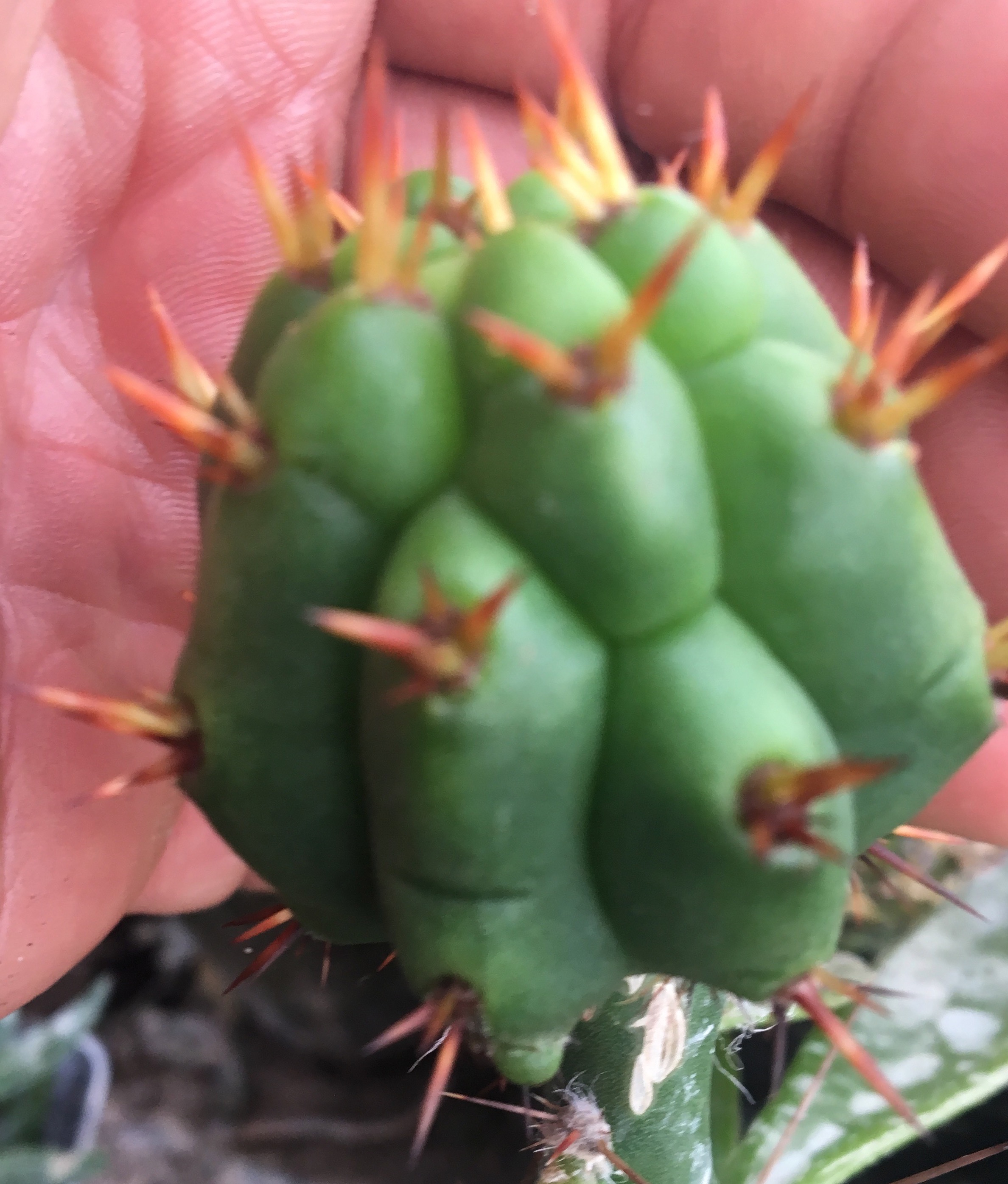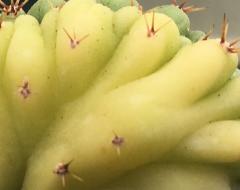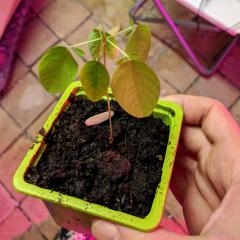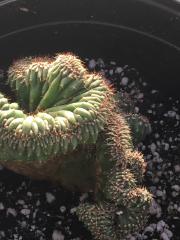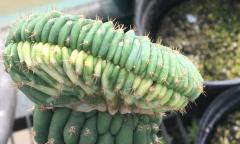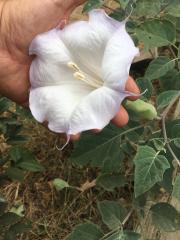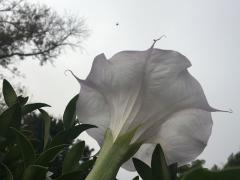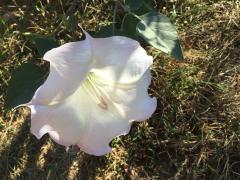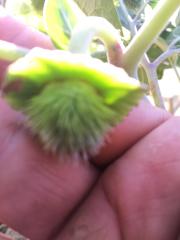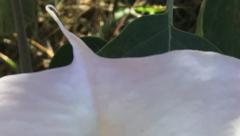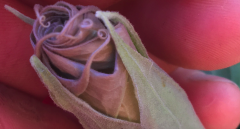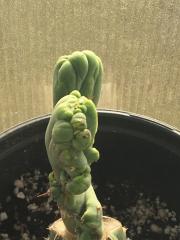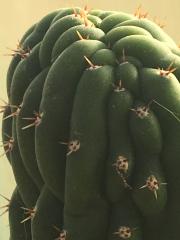-
Posts
1,233 -
Joined
-
Last visited
-
Days Won
44
Content Type
Profiles
Forums
Events
Blogs
Gallery
Store
Everything posted by Inyan
-
From the album: Trichocereus Freaks
Crested variegated Trichocereus pachanoi.-
- 3
-

-
- trichocereus pachanoi
- crested
-
(and 1 more)
Tagged with:
-
-
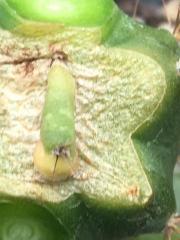
Zelly's trich crosses, got pics? post here please
Inyan replied to mushroomman's topic in Cacti & Succulents
Zelly seedlings update This is one of my favorites. However, these two might be close runners up if they were not so darn similar. A few more variegates have yet to take off due to the green house incident. I'm just amazed that at least one more variegate after being tossed clear across the green house is still going to grow or at least it appears to want to grow. Time will tell. I have several more flats of grafts completed from Zelly's seeds as well. I decided to put a short halt to my grafting however when I noticed these variegated specimens...A few hundred Zelly grafts to go yet so there is still much fun to be had. -
-

Basic info on how to hybridize Datura metel x D. wrightii
Inyan replied to Inyan's topic in Chill Space
No problem @Halcyon Daze, It is only by sharing information that truly great strides are made. Empowering others to make great hybrids is what its all about. The best way to do that is for everyone to share their knowledge. If your making hybrids or interested in making hybrids your drying and storing your pollen in the freezer or making pollen dilutions to extend your pollen further then I can only assume you have more than a passing interest in hybridizing as you have reached the point where you are not at the whim of what is blooming, but you can make the exact cross you are after provided it has bloomed for you at some point in the last few years. -
Would you settle for some root and ball medicine?
-

Succulent of the month? Which succulent is pushing your buttons?
Inyan replied to SayN's topic in Cacti & Succulents
-
From the album: Trichocereus Freaks
Variegated Trichocereus pachanoi-
- 6
-

-
- variegated
- trichocereus
-
(and 2 more)
Tagged with:
-
-
Trichocereus seeds I have for trade. Validus x (SS02 x SS01) Interested in interesting Trichocereus hybrids.
-
Athene Noctua I do believe I can trade you some Datura metel (hybrid) x Datura wrightii seeds if you would like. I'm always looking for nice pure species as well as hybrid Trichocereus seeds in particular, but I'm also open to other offers. Hit me up via pm.
-
From the album: Datura wrightii and hybrids
This is a very nice oblique view of my favorite Datura wrightti collected from the Mojave desert. Absolutely breathtakingly sweet fragrance is flowing across the field right now. No other Datura can compare with this one when it comes to sweet fragrance. -
From the album: Datura wrightii and hybrids
Datura wrightii on an overcast day. You can see the faint lavender coloring here much better and as stated before this lavender color can be variable on the same plant being more or less intense on any given day. What you can not see here however is the intensely sweet fragrance of this particular species. I don't know of any other Datura that is as sweet smelling as this one. -
Beautiful specimens you have there ☽Ţ ҉ĥϋηϠ₡яღ☯ॐ€ðяئॐ♡Pϟiℓℴϟℴ. I can tell you though that if you have one success at grafting you are in danger of having many more successes. You simply have to listen to what your grafts are telling you. Each time you graft you learn something then your doing something right even if your grafts are not all taking. Love the lights you have going on in your cacti room. That is totally cool. I just learned for instance, grafts don't do very well when they are literally tossed or thrown outside or flipped upside down early in the grafting process. I suspect I will find that at least a few will make it though. At least I have high hopes that some will make it. To that end, I made another 30 grafts today... of course now that my tags have all been moved or tossed about as well I don't know what I'm actually grafting. So, I've decided simply to graft as many seedlings as I can and hope that I find something worth keeping later after they have all bloomed. It is going to be a slow process as no matter what I think I keep getting interrupted and find it hard to graft more than 20-30 seedlings without someone coming to take up my time.
-
From the album: Datura wrightii and hybrids
Soft lavender tinted picotee edges are seen on this Datura wrightii var. Mojave. Tinting is variable on same plant and can have a variety of intensities. -
From the album: Datura wrightii and hybrids
Datura wrightii immature seed pod showing soft lavender tint over top green. Soft lavender tint also seen over portions of stem in background. Soft velvety coating visible overlaying lavender on stem. -
From the album: Datura wrightii and hybrids
Edge of Datura wrightii flower often light lavender to dark lavender. This particular specimen collected in Mojave desert.-
- 1
-

-
- datura wrightii var. mojave
- datura
-
(and 1 more)
Tagged with:
-
From the album: Datura wrightii and hybrids
Dature wrightii var. Mojave found in Mojave desert and collected. Note: Lavender tint to unopened flower is darkest along edges of flower and along edges of calyx. Lavender tint has been noted to be of variable intensity during different bloom cycles on the same plant. -
While she can not prove it, my significant other suspects the neighbors daughter who has been caught going through our barn, green house, etc. before. As it stands I have already lost several grafts as they have clearly detached from their stock plants and as many were areole grafts to begin with there is not much if anything to recut so they are gone in the wind to say the least. I am still holding out hope on some grafts, but it is hard to tell when you are dealing with parafilm as it is hard to see through it. If you try to tamper with it you will ruin the graft for sure... so it is a game of hurry up and wait to see exactly what can be salvaged.
-
All three were extensively propagated via just a few days ago via areole grafts along with some variegated specimens I have. Suffice it to say after the great disaster with my cacti being found both outside and inside my green house, it may be a while longer before I can offer some of these. It also hurts just a bit that my stock plants were brutalized. Everything either heals in time or is replaced by a new generation of seeds. So, no worries in the long run.
-
Today was not a good day. As you can see, many of my brand new grafts were destroyed as well as some grafting stock. Damage was found both in the green house and outside of the green house. Most upsetting wasn't the fact that many crests, variegates, etc. are now unlabeled and unknowns now... but in fact almost all of my grafts have had labels removed or tossed. It is not a good day for me to say the least. I found one small seedling that had been de-grafted while trying to fix everything up and suffice it to say I did re-graft the unknown seedling now and after that I pretty much lost the heart to do much else in the green house. Sadly, many of the crested and variegates I had were slated to be given out as gifts once they matured a bit more. Deep breathe in and relax. Now, I have to wait and see how many grafts will still pull through after having just been grafted in the last 3-4 days. This is going to be one heck of a learning experience.
-
From the album: Trichocereus Freaks
